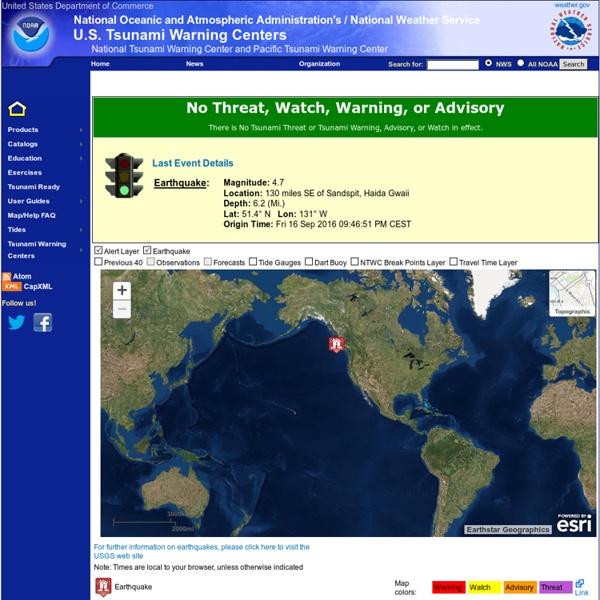



Waveforms from the HVO Seismic Network What's New The latest version of Volcweb was launched December 20, 2013. Based on feedback from our users (you), we have made the following adjustments: Auto-refresh: The webpage now automatically refreshes when the page has been inactive for 10 minutes. The dots presented in this map represent earthquake location calculated by the Hawaiian Volcano Observatory and its partners. Earthquakes are routinely reviewed by a seismic data analyst and updates posted to this web site. When an earthquake occurs, seismic waves are created, which propagate away from the focus or hypocenter. The magnitude of an event is determined from the strength of the seismic waves detected at each station.
Tsunami forecasting: The next wave A simulation of the 2011 Tohoku tsunami used data from buoys and sea-floor sensors (triangles) to estimate wave heights. Deeper colours indicate higher waves. As soon as the shaking died down on 11 March last year, Ken-Ichi Sato stumbled back to his office and pressed the alarm button, triggering sirens throughout the city of Kesennuma in northeastern Japan. As the emergency manager of the coastal community, Sato had to alert the 64,000 people there that a tsunami might be coming. A minute later, that threat became more real when Sato received word from the Japan Meteorological Agency (JMA) that the quake was large — magnitude 7.9 — and located off the coast of Miyagi Prefecture, where Kesennuma is located, in the Tohoku region. But when the tsunami hit around half an hour later, it dwarfed the original JMA estimates. Sato thinks that the toll might have been lower had he learned the true size of the tsunami earlier. Tried and true Kesennuma was hit hard by the tsunami. Ups and downs
The Global Earthquake Explorer General Info GEE is an education and outreach tool for seismology that aims to make it easy for non-seismologists to retrieve, display and analyze seismic data. It is intended for use in a classroom setting as a supplement to textbook material, which often lacks real world connections. Novices to the world of seismology can use GEE to explore earthquakes they've seen in the headlines, keep track of a recording station in their area, look at real-time seismic data, and more! Novices . . . can use GEE to explore earthquakes they've seen in the headlines. GEE is comprised of configurable learning "modules" that can be used to convey specific seismological concepts such as wave properties, the structure of the earth, and the differences between P and S waves. Technical Info GEE makes use of the Fissures/DHI for data delivery.
National Earthquake Information Center - NEIC Earthquake Hazards Program National Earthquake Information Center - NEIC The mission of the National Earthquake Information Center (NEIC) is to determine rapidly the location and size of all destructive earthquakes worldwide and to immediately disseminate this information to concerned national and international agencies, scientists, and the general public. The NEIC compiles and maintains an extensive, global seismic database on earthquake parameters and their effects that serves as a solid foundation for basic and applied earth science research. Earthquake Data Available from the NEIC Share this page: U.S. DOI and USGS link policies apply.
Global Disaster Alert and Coordination System U.S. Geological Survey Earthquake Hazards Program